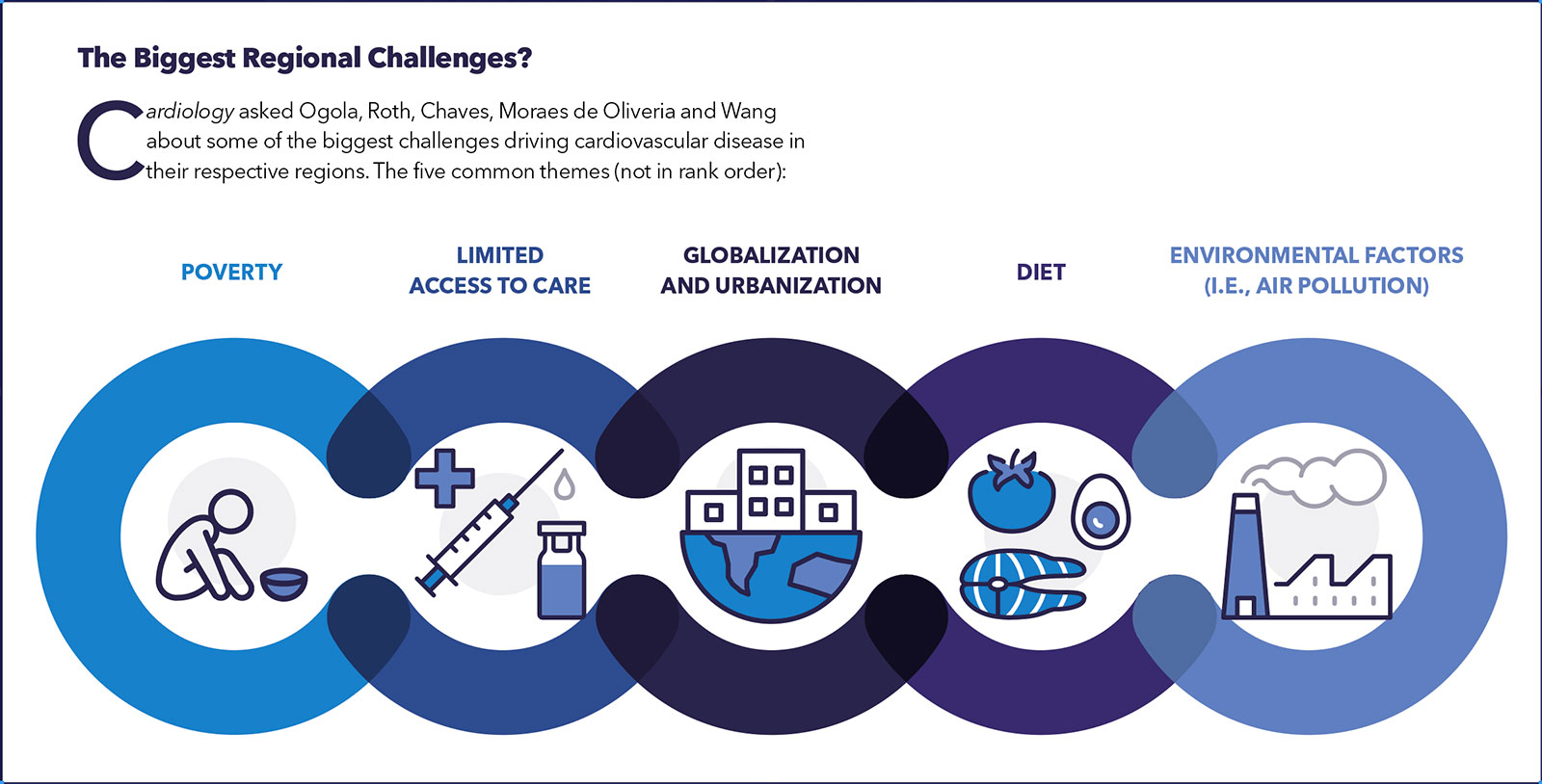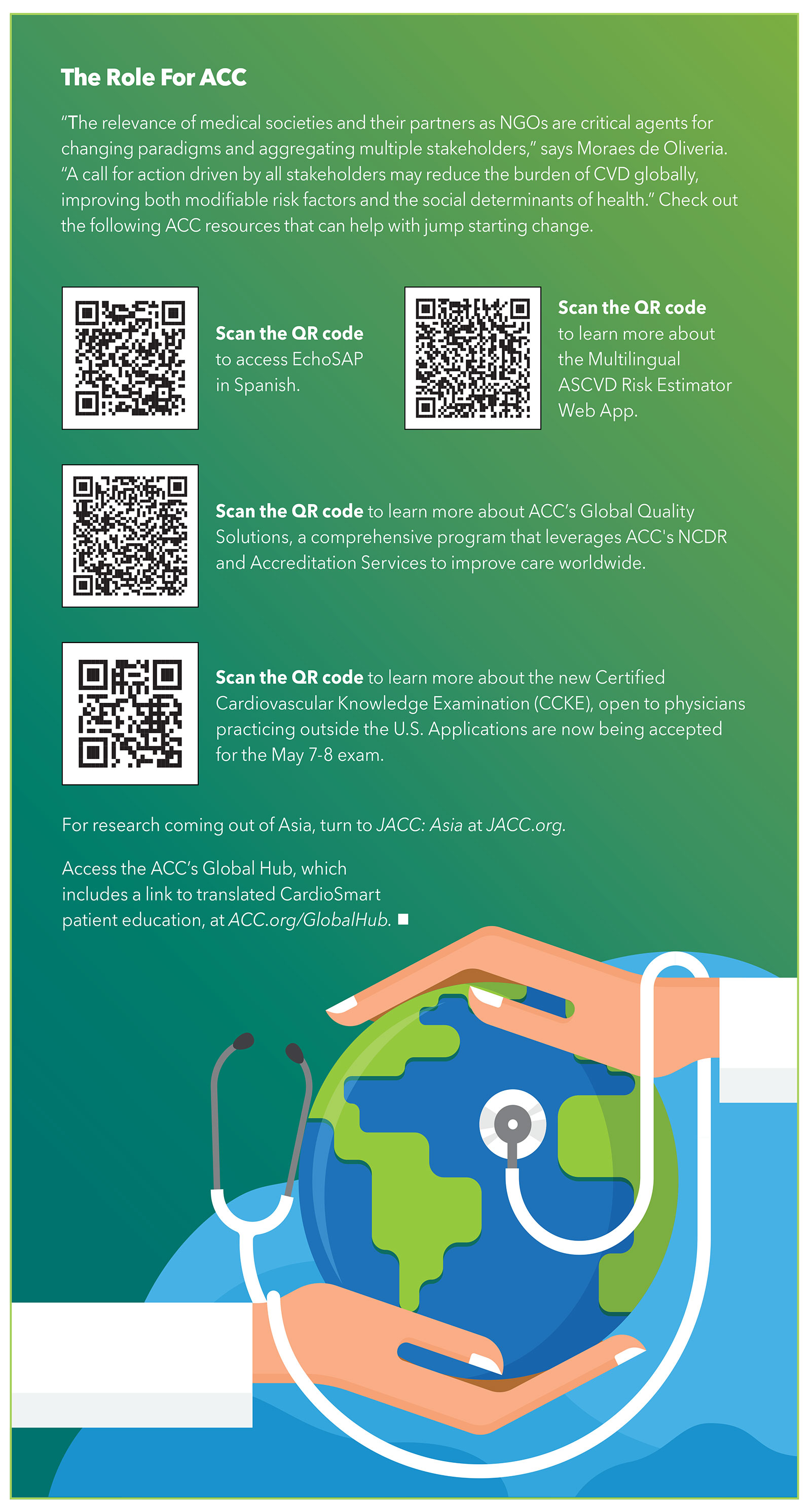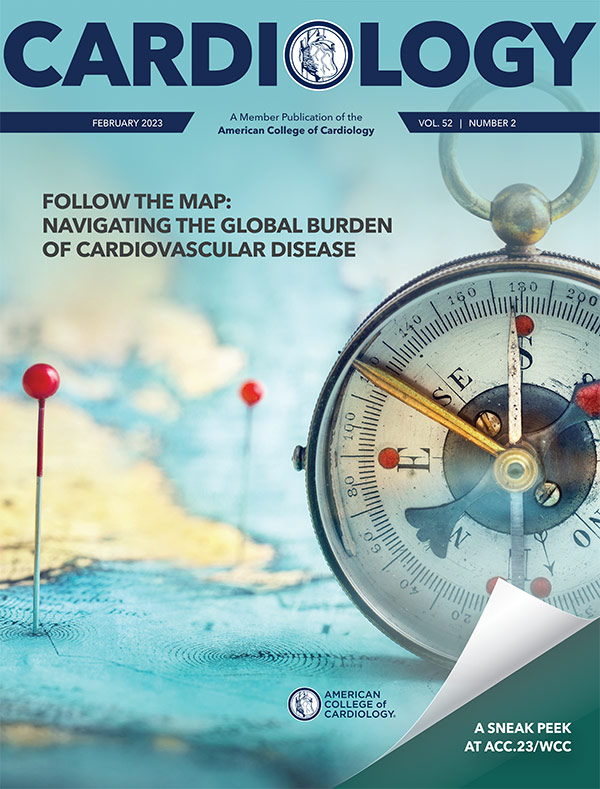Cover Story | Follow the Map: Navigating the Global Burden of Cardiovascular Disease
No matter what region of the globe, cardiovascular disease (CVD) remains the leading cause of death. Based on the most recent report from the multiyear Global Burden of Cardiovascular Diseases Collaboration between JACC, the Institute for Health Metrics and Evaluation (IHME), and the National Heart, Lung, and Blood Institute (NHLBI), while some regions are seeing progress in addressing specific cardiovascular conditions and risk factors, there are some alarming global trends that if left unaddressed will only increase the burden of CVD worldwide.
"Cardiovascular disease, in many ways, remains a silent killer," says Gregory A. Roth, MD, MPH, FACC, senior author of the new report, which was published in JACC in December 2022. "Even though most everyone sees the effects of cardiovascular disease in their daily lives, the toll is so enormous that many miss the overwhelming impact on a society."
The 2022 publication provides a broad view of the global burden of CVD, assessing CVD mortality and disability-adjusted life years (DALYs) using vital and sample registration data from 204 countries and territories. It specifically addresses 18 cardiovascular conditions and provides estimates for 15 leading risk factors for CVD: environmental (air pollution, household air pollution, lead exposure, low temperature, high temperature), metabolic (systolic blood pressure, LDL-C, body mass index, fasting plasma glucose, kidney dysfunction) and behavioral (dietary, smoking, secondhand smoke, alcohol use, physical activity.
"This study is a large advance and truly a monumental task," says Roth, who is adjunct associate professor of global health and health metrics sciences at IHME. "Our global collaborator network of over 8,000 people sorts through the health surveillance data from every country in the world, and integrates mortality systems, health surveys, electronic health facility data, as well as the universe of scientific studies coming out in greater and greater number every year. Not only do we analyze these data, but we are also looking for bias and errors, and developing methods to adjust and account for them."
Global CVD Trends
While CVD rates are high globally, Central Asia and Eastern Europe had the dubious honor of having the highest rates of CVD mortality in the world. Age-standardized CVD mortality rates in Eastern Europe ranged from 229.8 to 503.5 per 100,000 in 2021, while the CVD mortality rate in Central Asia was the highest among all 21 regions at 516.9 deaths per 100,000 – a whopping 6.8-times higher than the high-income Asia Pacific region which had the lowest CVD mortality rate at 76.6 deaths per 100,000.
Of the cardiovascular conditions assessed, ischemic heart disease was the leading cause of CVD mortality across all regions, accounting for 9.44 million deaths in 2021 and 185 million DALYs. Of note, however, Australasia did see the largest percent decrease in ischemic heart disease at 71.8%.
In terms of risk factors, hypertension, high cholesterol, dietary risks and air pollution were among the leading causes of CVD worldwide. Dietary risks accounted for 6.58 million CVD deaths and 8 million deaths overall in 2021, while high systolic blood pressure continued to account for the largest proportion of DALYs out of all risk factors, accounting for 10.8 million CVD deaths and 11.3 million deaths overall in 2021. The all-cause DALYs due to hypertension were 2,770 per 100,000 people.
Regional Trends on the Rise
Outside of broad global trends, the 2022 report highlights several regional trends. For example, non-rheumatic valvular heart disease had the largest percent increase in CVD cause-specific age-standardized mortality rate since 1990 in Central Asia (410.8%), Central Europe (144.4%) and Eastern Europe (341.0%), while endocarditis was on the rise in regions like Australasia, Western Europe and both Tropical and Central Latin America.
"The epidemiologic profile of endocarditis has evolved in the past decade, tending toward more severe clinical presentations, with a higher prevalence of comorbidities and nosocomial endocarditis and a higher frequency of prosthetic valves and electronic devices," says Gláucia Maria Moraes de Oliveria, MD, MSc, PhD, FACC, who has been an active champion of ACC initiatives in Brazil. "Early diagnosis is paramount to improving endocarditis outcomes; however, delays in diagnosis due to scarcity of resources and access to surgical treatment may interfere with the prognosis of the disease in regions like Tropical and Central Latin America." She adds that despite the unquestionable diagnostic and therapeutic advances in the management of endocarditis in past decades, long-term survival is also low, with mortality rates increasing from 40% in the first year to 70% by the 10th year. This may be another reason for increased mortality globally, she says.
Lower extremity peripheral arterial disease (PAD) was also called out for a substantial percentage increase in CVD mortality in South Asia, North Africa and the Middle East, and all regions of Sub-Saharan Africa. According to Elijah Ogola, MD, FACC, president of the ACC Africa Consortium Chapter, some of the increase in Africa may be due to increased rates of smoking and other adverse lifestyle factors. However, he also notes that increased awareness and diagnostic capabilities are also likely factors.
While hypertensive heart disease had the highest age-standardized DALY rate, outside of ischemic heart disease and stroke, for a large number of regions worldwide, alcoholic cardiomyopathy was highest in Eastern Europe, aortic aneurysm was highest in Eastern Asia, and rheumatic heart disease was highest in South Asia. Additionally, Central Asia, Oceania and Eastern Europe had the highest rates of cardiovascular disease burden attributable to dietary risk.
"Increased production of processed food, rapid urbanization and changing lifestyles have led to a shift in dietary patterns," says JACC: Asia Editor-in-Chief Jian'an Wang, MD, PhD, FACC. "In China, for example, a high sodium diet is one of the leading risk factors contributing to death and DALYs. There was a geographic pattern in the sodium intake, with the highest found in northern China."
Trending Positive
Despite some of the more alarming trends, there is also some good news when it comes to improvements in the global CVD burden. As mentioned earlier, Australasia saw a significant decrease in ischemic heart disease deaths, while the High-Income Asia Pacific Region saw its largest decrease in hypertensive heart disease rates. Similarly, Western Europe saw its largest decrease in rates of stroke.
Also of note, a majority of regions saw their largest percentage decreases in rates of rheumatic heart disease, one of the most common causes of cardiovascular morbidity and early mortality in children and young adults. While there is still much work to be done, a recent four-part JACC Focus Seminar on rheumatic heart disease highlights new data on disease burden and local programs that are helping to drive advances in diagnosis and management and may be contributing to improvements in patient outcomes.
Click here for a recent article on rheumatic heart disease in Cardiology.
Time For Risk Reduction
While progress is being made in some areas, the overall reality is that the burden of CVD is very real and has the potential to worsen without action to address modifiable risk factors. The good news is that more than 80% of CVD is preventable.
"These data serve as a timely reminder about the importance of modifiable risk factors for heart disease," says George A. Mensah, MD, FACC, an author of the paper and director of the Center for Translation Research and Implementation Science at NHLBI. "For example, deaths due to hypertension have steadily increased in the U.S. for the past 20 years, which mirrors trends in other regions and leaves researchers eager to find practical and innovative solutions."
Wang echoes these sentiments, noting that China, like the U.S., is among those countries with hypertension on the rise. He stresses the importance of early screening and intervention, as well as the need for more efforts to improve patient health literacy and encourage healthy habits to reduce risk factors like hypertension.
On the list of healthy habits: smoking cessation, regular exercise and improved diet. Diet is particularly important, according to Moraes de Oliveria and Daniel Quesada Chaves, MD, FACC, governor of the ACC Central America Chapter and co-chair of ACC Latin America 2023 Together With Asociación Costarricense de Cardiología, who say the consumption of ultra-processed and less healthy foods and sugar-sweetened beverages, especially in poorer areas where they are often the cheapest options, is related to an increase in risk factors like obesity, diabetes, high cholesterol and hypertension in Brazil, Latin America and elsewhere.
"It is crucial to correct the dietary risk by improving the consumption of fruits, vegetables, legumes, whole grains, dairy, fiber and polyunsaturated fatty acids … and reducing the consumption of red meat, processed meat, sugar-sweetened beverages, trans-fatty acids and sodium," says Moraes de Oliveria.
Encouraging exercise and educating about the harms of smoking starting as soon as early childhood is also necessary across all regions. Everyone interviewed for this article highlighted the notable declines in physical activity among youth, especially in urban areas, and noted the rise of smoking and alcohol consumption among adolescents and young adults, as well as women. "All of these accumulated cardiovascular risks begin early in life and support the need for lifelong health promotion efforts that start as early as pregnancy and early childhood," says Moraes de Oliveria.
Learning From Each Other
Reducing the global burden of CVD will require a change in culture. "To get there, we will need a society that embraces, and sees the possibilities for, cardiovascular prevention," says Roth. "Cardiovascular disease is not just one problem, but really hundreds of different issues that are connected."
Sharing research and understanding how other countries are working to address access to care and modifiable risk factors are critical to this effort. For example, Roth cites the wider use of low-dose polypills for high blood pressure or the broad adoption of inclisiran for secondary prevention, which is being done in England. He also highlights other tools for improving public health, such as educational programs for young children that will help prevent metabolic disease later in life and use of digital technology like low-cost portable devices that screen for arrhythmias to tracking fitness and diet.
Government programs are also helping to reduce the burden of CVD. Chaves notes multidisciplinary primary prevention programs developed by the Mexico Social Security Institute, while Moraes de Oliveria says expanded access to medicines used to manage diabetes and hypertension through the Popular Pharmacy Program in Brazil have resulted in significant reductions in hospital admissions and deaths from these diseases. In recent years, Wang says China has also launched several strategies with a significant continuity in terms of addressing risk factors associated with hypertension, including tobacco control initiatives and a National Fitness Campaign.
"These actions have made some progress in the management of hypertension," Wang says. "A series of national surveys showed that the rates of awareness, treatment and control of hypertension improved significantly in recent years. And the number of hypertension patients under standardized management has more than doubled since 2010."
On the obesity and diet front, the National Strategy for the Prevention and Care of Childhood Obesity in Brazil is reducing the prevalence of obesity in children and adolescents with an emphasis on school lunches and nutrition education. Similarly in China, Wang says the "China Healthy Lifestyles for All" program initiated by the Chinese government in 2007, followed by the "Healthy China Action Plan" released in 2019, have had some success in reducing salt intake across China.
Several regions and countries are also tackling issues associated with patient access to care. In Africa, Ogola says there are attempts at capacity building using nonspecialists to facilitate task sharing and increase access to care, while in Latin America, Chaves says primary care physicians are delivering educational and lifestyle interventions to reduce risks factors.
What's next? Roth says vascular health should be part of education for children and young people. Both he, Chaves and Wang also highlight the importance of sustained and advanced tobacco regulation and anti-smoking laws, which remain among the most effective policies for lowering smoking rates and improving heart health. Expanding the potential uses for, and the availability of, polypills, including in the U.S., is also an opportunity. Roth says that better emergency care is also an important goal, and investment in prehospital and hospital services will be key. "In particular, countries that are just starting to build out these systems have the chance to do it more rationally than has been done before," he says.
Clinical Topics: Acute Coronary Syndromes, Arrhythmias and Clinical EP, Heart Failure and Cardiomyopathies, Prevention, Valvular Heart Disease, Vascular Medicine, Implantable Devices, SCD/Ventricular Arrhythmias, Atrial Fibrillation/Supraventricular Arrhythmias, Acute Heart Failure, Anticoagulation Management, Cardiac Surgery, Cardio-Oncology, Cardiovascular Care Team, Congenital Heart Disease and Pediatric Cardiology, COVID-19 Hub, Diabetes and Cardiometabolic Disease, Dyslipidemia, Geriatric Cardiology, Invasive Cardiovascular Angiography and Intervention, Noninvasive Imaging, Pericardial Disease, Pulmonary Hypertension and Venous Thromboembolism, Sports and Exercise Cardiology, Stable Ischemic Heart Disease
Keywords: ACC Publications, Cardiology Magazine, ACC Scientific Session Newspaper, ACC Annual Scientific Session, ACC23, ACC International, Heart Failure, Acute Coronary Syndrome, Aneurysm, Heart Valve Diseases, Arrhythmias, Cardiac, Secondary Prevention, ACC.23/WCC Meeting Newspaper
< Back to Listings






